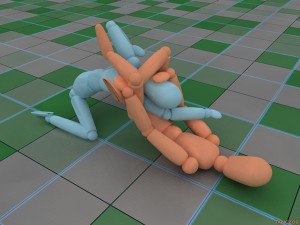 It’s been a while since we’ve done Bas Rutten’s All-Around Fighting Workout #2 in class. I hope everyone enjoyed it as much as I did last night.
It’s been a while since we’ve done Bas Rutten’s All-Around Fighting Workout #2 in class. I hope everyone enjoyed it as much as I did last night.
I will never claim to be a BJJ expert (or even a smidgen above average amongst my peers), but I’d like to offer a few simple changes you can make to your grappling strategy that will make a big difference.
- Control your breathing and don’t waste energy!
The first time I grappled in a Level 2 class I was nauseous by the end of it. When I started training BJJ, one of the first things I learned was to control my breathing if I wanted to make it to the end of class. Some of this comes with improving metabolic conditioning, but more important is consciously controlling how hard you’re sucking wind. An excellent strategy is to find relatively safe “resting positions”. Listen to your partner’s breathing. Is he or she gasping for breath? Try to make your breathing more controlled than his/hers. If you’re in a dominant or safe position, let them gas themselves out, then make your move.
Coupled with this is not wasting energy by trying to “muscle” every move. Jiu-jitsu is a system based on manipulating balance and leverage. It is referred to as the “gentle art”. Brazilian Jiu-Jitsu was developed by Carlos Gracie so that a smaller person did not have to rely on strength to defeat a larger opponent. It is often said that if you are using strength, you are not doing jiu-jitsu. Persistence is important in setting up positions and submissions, but so is knowing when to quit and transition to a new tactic before expending all your energy. - When squaring off on your knees, anticipate your partner’s reactions.
Sometimes you can just bulldoze straight into your partner to get him or her into a compromised position, but a more useful strategy is to get him/her thinking one way, then pull the ol’ switcheroo. Clinch up and push into your partner; as he/she pushes back, pull. The reverse also works. Push to one side, then flip the direction. Occupy your partners arms, then pull guard. Be tricky! - Keep your arms close to your body.
This is especially true if you’re on your back and trying to get your partner off of you. Don’t extend your arms; keep your elbows close to your body to seal up “holes” your partner can use to set up submissions. - When in someone’s guard, maintain a solid base.
There are different techniques and strategies for passing guard (postured up, head down, etc.) but your base must be solid regardless. Without a solid base, you are more easily swept or set up for a submission. As a basic starting point, keep your hips low and your knees wide. If you are postured up, try to keep your head vertically in line with your hips to make it harder for your partner to break you down. - You’re not going to get a submission from inside the guard.
It’s very hard to pull off a submission while in someone’s guard because they can control your hips with their legs. As soon as you think you’re close enough to crank on a choke or an arm lock, all they have to do is extend their legs and torso. Position before submission: use your energy passing guard and getting a dominant position before attempting submissions. Also, trying these submissions often requires you to reach toward your partner’s head, exposing your arms to submissions. - You need your legs and hips for a guillotine choke.
Or, more precisely, you need to control your partner’s legs and hips. Like submissions from within guard, it’s not impossible to finish without lower-body control, but it’s not very likely. Trying to rip your partner’s head off from any and all positions does little more than waste your energy and give your partner a stiff neck for the rest of the week. Only go for the guillotine if you can secure guard, half guard, or if you’re in your partner’s half guard. - We’re all learning. Have fun!
We’re not training for competition, so don’t concern yourself with “who’s winning”. Part of learning is getting your guard passed and getting tapped. A lot. And then some more. Anyone can get caught on any given day, so just have fun and learn!
Of course, the most important thing to remember is that sport-style grappling is, for us as Krav Maga trainees, one training method in our overall approach to self-defense. We use grappling as a way to acclimate ourselves to and safely train groundfighting—though keep in mind that we never want to have a prolonged fight on the ground for so many reasons.
Questions? Comments? Again, I’m not the resident BJJ expert, but I love this stuff and am happy to share what I know. Grab me at the school or post to the comments below.
Triangle Choke image from Scientific Images.



[…] “Grappling Quick Tips” […]